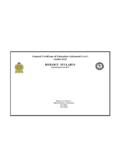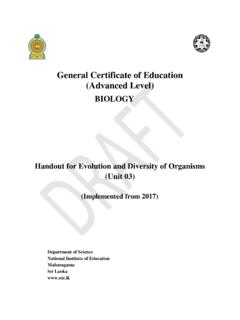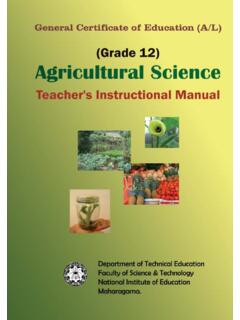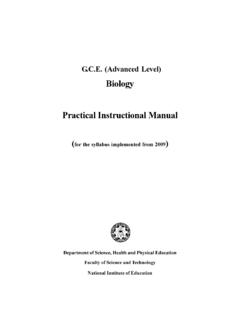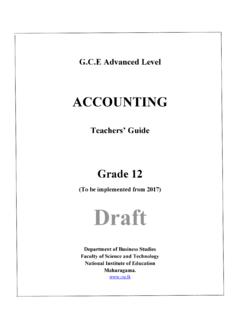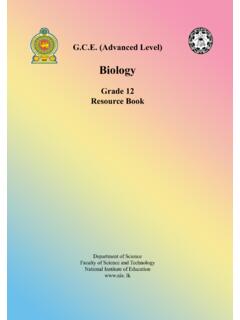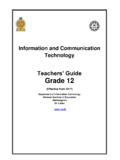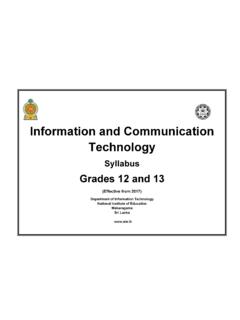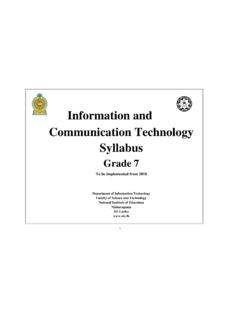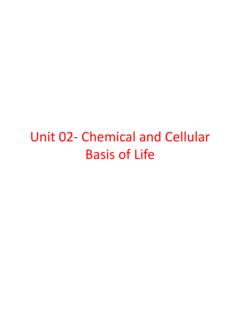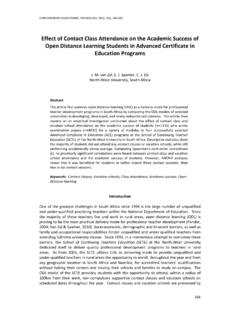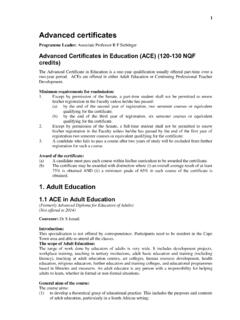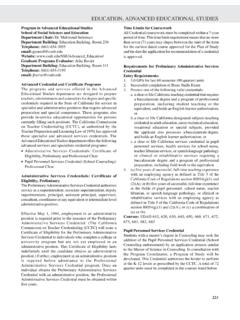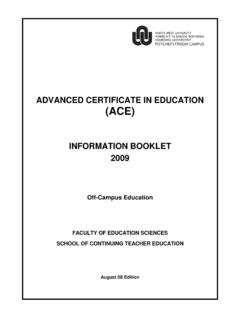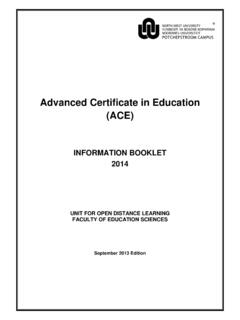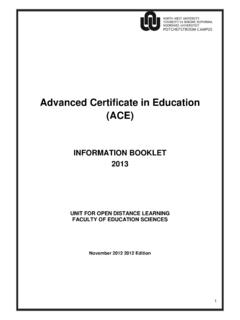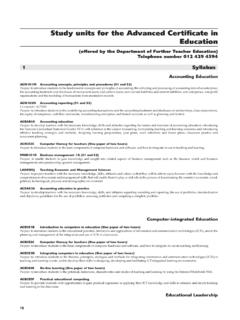Transcription of General Certificate of Education (Advanced Level)
1 I General Certificate of Education ( advanced Level) GRADES 12-13 CHEMISTRY SYLLABI(Implemented from 2017)Department of ScienceNational Institute of EducationMaharagamaSri i iINTRODUCTIONThis syllabus had been designed to provide a basic background of chemistry that would be required by those intending to proceed tohigher studies as well as by those who would utilize their knowledge of chemistry gained at the GCE(A/L) in various other syllabus comprises 14 units presented in a sequence appropriate (but not mandatory) to be followed during teaching.
2 The presentationof the subject matter in each unit is organized on the basis of experiments indicated in italics at the end of subunits are an essential component of the syllabus, illustrating the link between theoryand experiment. This syllabus is effective from of the New SyllabusThe following changes have been made in the new syllabus which will be implemented from 2017 onwards. The total number of periods was reduced from 468 to 450 giving room for more revision work. The flow of the content of unit 01 has been rearranged and the details of the properties of , and radiations were removed.
3 The content of unit 02 was rearranged by indicating relevant limitations. (Resonance structures of selected molecules and ions only wereconsidered. Examples: O3, N2O, CO2, CO32-, NO3, NO2and similar molecules and ions) Lattice structures of diamond, graphite and silica have been shifted to unit 06. The content of unit 03 has been expanded and the number of periods has been following content has been introduced to unit 03. More periods have been allocated to solve problems related to stoichiometry. Preparation of content of unit 04 has been restructured.
4 The content of unit 05 has not been changed. The content of unit 06 was changed and restructured. IUPAC nomenclature of d complexes with only one following new practical works have been introduced to unit 06 Showing the presence of nitrogen in air by experiment. Standardization of a solution of S2O32- ions using KIO3 and I-. Determination of the concentration of a Fe2+ ion solution using acidified KMnO4. Experimental determinations of the concentration of a K2C2O4 solution using a standard solution of acidified practical works in the former syllabus have been removed from unit 06 Preparation of allotropes of sulphur.
5 Preparation of sulphur dioxide and testing its properties. Preparation of chlorine. Unit 08 and unit 09 have been combined into a single unit under the title hydrocarbons and halohydrocarbons without changing thecontent. The content of Unit 11 has been rearranged without changing the content. The sequence of the content of unit 12 has been following experiments were removed from unit 12 Preparation of an indicator using flowers provided and experimental determination of its pH range Determination of the approximate pH value of a given solution using pH indicatorsi vThe following experiments have been introduced to unit 12 Titration between sodium carbonate and hydrochloric acid using phenolphthalein and methyl orange.
6 The content of Unit 13 has been changed. Bimetallic corrosion, cathodic protection and passivation have been following experiments have been removed from unit 13 Measuring the electromotive force of different cells Preparation of hydrogen and oxygen by electrolysis of water Electroplating with copper and silver Experimental study of corrosion as an electrochemical processThe following experiments have been introduced to unit 13 Experimental determination of relative position of commonly available metals in the electrochemical series.
7 Preparation of standard Ag/AgCl(s) electrode Units 15 and 16 were completely changed and combined into a single unit unit 14 under the title Industrial chemistry and content has been removed from unit 15. Extraction of sodium (Downs cell method) Production of common salt Production of ureav Compounding of natural rubber Some plant based industries (paper, pharmaceuticals) Chromatography (liquid and paper ) Chemistry of the production of cement. Crude oil and cracking/ production of following content has been introduced unit 14 Uses of ethanol, vinegar, essential oil and biodiesel.
8 Effects of plastic additives for polymerization. Production and uses of titanium dioxide from following experiment has been removed from Unit 15. Separation of mixture of leaf pigments using paper following experiments were introduced to unit 14 Extracting cinnamon oil from cinnamon leaves by steam distillation. Preparation of biodiesel. Determination of the percentage of acetic acid in following content has been removed from unit 16. Constituents of the ecosphere and their significance. Role of biochemical processes maintaining the life on the earth.
9 Investigates contamination of soil and the soil National on the concept of respecting human values and understanding the differences between the Sri Lankan multi-cultural society, buildingup the nation and confirming the identity of Sri Lanka by promoting national integrity, national unity, national coherence and responding to the challenges of the dynamic world, identifying and conserving the national an environment which comprises the conventions of social justice and democratic life to promote the characteristics of respectinghuman rights, being aware of the responsibilities, concerning each other with affectionate a sustainable life style based on the people s mental and physical wellbeing and the concept of human positive feelings needed for a balanced personality with the qualities of creative skills, initiative, critical thinking and the human resources.
10 Needed for the progress of the wellbeing of an individual, the nation as well as the economic growth ofSri Lanka, through the people for the changes that occur in a rapidly changing world by adapting to it and controlling them; developing abilities andpotentialities of people to face the complex and unexpected the skills and attitudes based on justice, equality, mutual respect which is essential to achieve a respectable place in theinternational Education Commission Report (2003). Basic CompetenciesviiThe competencies promoted through the Education mentioned below help to achieve the above mentioned National Competencies in CommunicationThis first set of competencies is made up of four subsets - Literacy,Numeracy, Graphics and InformationCommunication skills:Literacy :Listening, carefully speaking clearly, and reading for comprehension, writing clearly :Using numbers to count, calculate, code and to measure, matter, space and.
